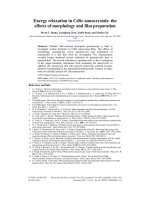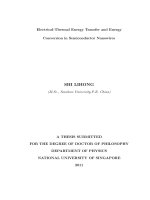Lecture energy flow in ecosystems
Bạn đang xem bản rút gọn của tài liệu. Xem và tải ngay bản đầy đủ của tài liệu tại đây (1.14 MB, 32 trang )
ENERGY FLOW IN ECOSYSTEMS
• All organisms require energy:
for growth, maintenance, reproduction, locomotion, etc.
• Hence, for all organisms there must be:
A source of energy
A loss of usable energy
Types of energy
heat energy
mechanical energy
(+gravitational energy, etc.)
chemical energy
= energy stored in molecular bonds
The distribution of sola radiation energy in the biosphere
0.8% 0.2%
Heating air, land,
ocean
Evaporation
30.0%
46.0%
Reflection
Photosynthesis
23.0%
Wave, wind
This pattern of energy flow among different organisms is
the TROPHIC STRUCTURE of an ecosystem
Transformations of energy
The transformations of energy from solar radiation
to chemical energy and mechanical energy and
finally back to heat of Ecosystem Ecology.
Energy and biomass pyramids
The concepts
• PG: Gross primary productivity
– = the total rate of photosynthesis
– = the rate of energy capture by producers (kcal/m2/yr)
– = the amount of new biomass of producers (g/m2/yr)
• PN = PG – R; Net primary production is thus the amount of
energy stored by the producers and potentially available to
consumers and decomposers
• B: Standing crop Biomass – the amount of accumulated
organic matter found in an area at a given time
The concepts
• NU: Not consumed
• NA: Undigested / Fecal wastes
• R: Respiration
•
P: Secondary productivity
– the rate of production of new biomass by consumers,
– the rate at which consumers convert organic material into new
biomass of consumers
The common method of measuring PN
Terrestrial ecosystems
To estimate the change in Standing crop Biomass over a given time
interval (t2 –t1)
B = B(t2) – B(t1)
PN = B + D + C
D: loss of biomass due to the dead of plants from t1 to t2
C: loss of biomass due to consumption by consumer
The common method of measuring PN
Aquatic ecosystems
To estimate the change in O2 concentration in light/dark bottle
Water sample containing phytoplankton
O2 produced by photosynthesis
O2 consumed in respiration
Limiting Factors control PN in Terrestrial ecosystems
Limiting Factors control PN in Aquatic ecosystems
100
12
10
8
6
PN
10
Light intensity
(% of suface value)
50
4
2
0
0
20
40
60
80
100
120
Nitrogen concentration (mg/l)
140
160
Primary production varies with time
Primary production varies with time
Primary production varies with time
Primary production varies with time
Primary production varies with time
Net primary production (NPP) and standing biomass allocation for
a 90-year-old Michigan forest estimated from inventory-based
methods in which biomass growth is quantified over time
(Gough et al. 2008)
Primary productivity limits secondary production
Net primary productivity (kJ/m2/yr)
Primary productivity limits secondary production
Trophic efficency (TE): the ratio of productivity in
a given trophic levelGrowth
(Pn) to trophic level it feeds
on (Pn-1Respiration
)
33J
Undigested
100J
67J
(P)
TE = Pn / Pn-1
Growth efficency: the ratio of energy for growth to
total energy
200J (A)
Growth efficency (P/A) = 33/200 = 16,5%
Production efficiency (x100) of various animal group
(Humphrey, 1979)
Group
P/A (%)
Group
P/A (%)
Mice
4.10
Orthoptera
41.67
Voles
2.63
Hemiptera
41.90
Other mammals
2.92
All other insects
41.23
Birds
1.26
Mollusca
21.59
Fish
9.74
Crustacea
24.96
8.31
All other noninsect
invertebrates
27.68
Social insects
General patterns of energy flow through ecosystems
(Begon et al, 1986)
FOREST
Respiration
Respiration
GRAZER
SYSTEM
DECOMPOSER
SYSTEM
NET PRIMARY
PRODUCTIVITY
DEAD ORGANIC
MATTER









